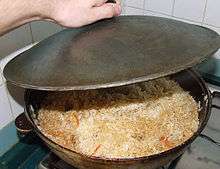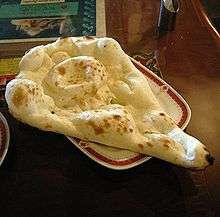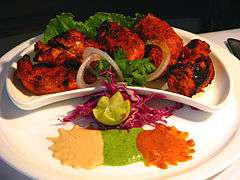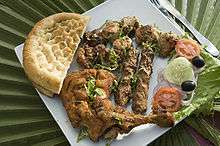Pilaf
|
Uyghur polo | |
| Alternative names | Pilav, pallao, pilau, pelau, pulao, pulaav, palaw, palavu, plov, palov, polov, polo, polu, kurysh, fulao, fulab, fulav |
|---|---|
| Course | Main |
| Region or state | Central Asia, Middle East, South Asia, East Africa |
| Serving temperature | Hot |
| Main ingredients | Rice, spices, meat or fish, vegetables, dried fruits |
|
| |
Pilaf is a dish in which rice is cooked in a seasoned broth.[1] In some cases, the rice may attain its brown or golden colour by first being sauteed lightly in oil before the addition of broth. Cooked onion, other vegetables as well as a mix of spices may be added. Depending on the local cuisine, it may also contain meat, fish, vegetables, pasta, and dried fruits.
Pilaf and similar dishes are common to Balkan, Middle Eastern, Caucasian, Central and South Asian, East African, Latin American and Caribbean cuisines. It is a staple food and a national dish in Afghan, Armenian, Azerbaijani, Bangladeshi, Balochi, Bukharan Jewish,[2] Cretan, Indian, Iranian, Kazakh, Kyrgyz, Kurdish, Pakistani, Swahili (Kenyan, and Tanzanian-Zanzibari), Uyghur, Uzbek,[3][4] Tajik[5] and Turkish[6] cuisines.
Etymology
The English term pilaf is borrowed directly from the Turkish pilav, which in turn comes from Persian polow (پلو), Hindi pulāo, from Sanskrit pulāka (meaning "a ball of rice"), which in turn, is probably of Dravidian origin.[7] The English spelling is influenced by the Modern Greek pilafi (πιλάφι), which comes from the Turkish pilav.[8]
History

The ancient Hindu text Mahabharata from India, mentions rice and meat cooked together, and the word "pulao" or "pallao" is used to refer to the dish in ancient Sanskrit works, such as Yājñavalkya Smṛti.[9][10]
Pilaf was known to have been served to Alexander the Great at a royal banquet following his capture of the Sogdian capital of Marakanda (modern Samarkand). It is believed that soldiers from Alexander's army brought the preparation of pilaf back to Macedonia, after which it spread throughout Ancient Greece.
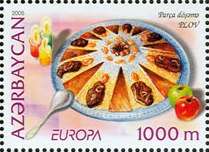
The first known recipe for pilaf is by the tenth-century Persian scholar Abu Ali Ibn Sina (Avicenna), who in his books on medical sciences dedicated a whole section to preparing various dishes, including several types of pilaf. In doing so, he described advantages and disadvantages of every item used for preparing the dish. Accordingly, Uzbeks and Tajiks consider Ibn Sina to be the "father" of modern pilaf.
Pilau became standard fare in the Middle East and Transcaucasia over the years with variations and innovations by the Persians, Arabs, Turks, and Armenians. It was introduced to Israel by Bukharan and Persian Jews.
During the period of the Soviet Union, the Central Asian versions of the dish spread throughout all Soviet republics, becoming a part of the common Soviet cuisine.
Local varieties
India
Known as pulao, pallao and pulav locally, the rice dish has been an integral part of the Indian and other South Asian cuisine since the ancient era. The ancient Hindu text Mahabharata from India, mentions rice and meat cooked together, and the word "pulao" or "pallao" is used to refer to the dish in ancient Sanskrit works, such as Yājñavalkya Smṛti.[9][10] A pulao is a dish consisting of rice and a mixture of either lentils or vegetables, mainly including peas, potatoes, french beans, carrots or meat, mainly chicken, fish, lamb, pork or prawn. It is usually served on special occasions and weddings, though it is not uncommon to eat it for a regular lunch or dinner meal. It is considered very high in food energy and fat. A pulao is often complimented with either spiced yogurt or raita. Biryani is another rice dish in the Indian cuisine, similar to pulao, albeit with a different cooking method. The main distinction is that a biryani comprises layers of rice with meat or vegetables, the pulao is not layered.[11]
Iran
Persian culinary terms referring to rice preparation are numerous and have found their way into the neighbouring languages: polov (rice cooked in broth while the grains remain separate, straining the half cooked rice before adding the broth and then "brewing"), chelov (white rice with separate grains), kateh (sticky rice) and tajine (slow cooked rice, vegetables, and meat cooked in a specially designed dish also called a tajine). There are also varieties of different rice dishes with vegetables and herbs which are very popular among Iranians.
There are four primary methods of cooking rice in Iran:
- Chelov: rice that is carefully prepared through soaking and parboiling, at which point the water is drained and the rice is steamed. This method results in an exceptionally fluffy rice with the grains separated and not sticky; it also results in a golden rice crust at the bottom of the pot called tahdig (literally "bottom of the pot").
- Polov: rice that is cooked exactly the same as chelov, with the exception that after draining the rice, other ingredients are layered with the rice, and they are then steamed together.
- Kateh: rice that is boiled until the water is absorbed. This is the traditional dish of Northern Iran.
- Damy: cooked almost the same as kateh, except that the heat is reduced just before boiling and a towel is placed between the lid and the pot to prevent steam from escaping. Damy literally means "simmered".
In Persian cuisine, rahkshi (also known as yahni), a soup or stock, is often served over pilaf (pulao).
Central Asia
Central Asian, e.g. Tajik and Uzbek plov (Tajik: палав, palav, Uzbek: palov) or osh differs from other preparations in that rice is not steamed, but instead simmered in a rich stew of meat and vegetables called zirvak, until all the liquid is absorbed into the rice. A limited degree of steaming is commonly achieved by covering the pot. It is usually cooked in a kazan (or deghi) over an open fire. The cooking tradition includes many regional and occasional variations.[3][12] Commonly, it is prepared with lamb, browned in lamb fat or oil, and then stewed with fried onions, garlic and carrots. Chicken plov is rare but found in traditional recipes originating in Bukhara. Plov is usually spiced with whole black cumin, coriander, barberries, red pepper, marigold, and pepper. Heads of garlic and garbanzo beans are buried into the rice during cooking. Sweet variations with dried apricots, cranberries and raisins are prepared on special occasions.
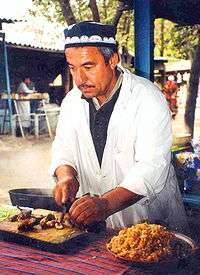
Although often prepared at home for family and guests by the head of household or the housewife, palov is made on special occasions by the oshpaz (osh master chef), who cooks the national dish over an open flame, sometimes serving up to 1,000 people from a single cauldron on holidays or occasions such as weddings. Oshi nahor, or "morning plov", is served in the early morning (between 6 and 9 am) to large gatherings of guests, typically as part of an ongoing wedding celebration.
The Uzbek-style plov cooking recipes are spread nowadays throughout all post-Soviet countries.
Afghanistan
In Afghan cuisine, Kabuli palaw or qabili palaw (Dari : قابلی پلو ) is made by cooking basmati with mutton, lamb, beef or chicken, and oil. Kabuli Palaw is cooked in large shallow and thick dishes. Fried sliced carrots and raisins are added. Chopped nuts like pistachios, walnuts, or almonds may be added as well. The meat is covered by the rice or buried in the middle of the dish. The Kabuli Palaw rice with carrots and raisons is very popular in Saudi Arabia, where it is known as roz Bukhari (Arabic: رز بخاري), meaning Bukharan rice.
Azerbaijan
Azerbaijani cuisine includes more than 40 different plov recipes.[13] One of the most reputed dishes is plov from saffron-covered rice, served with various herbs and greens, a combination distinctive from Uzbek plovs. Traditional Azerbaijani plov consists of three distinct components, served simultaneously but on separate platters: rice (warm, never hot), gara (fried meat, dried fruits, eggs, or fish prepared as an accompaniment to rice), and aromatic herbs. Rice is not mixed with the other components even when eating plov.[14]
Greece
In the Greek cuisine, piláfi (πιλάφι) is the fluffy and soft, but neither soupy nor sticky, rice that has been boiled in a meat stock or bouillon broth. In Northern Greece, it is considered poor form to prepare piláfi on a stovetop; the pot is properly placed in the oven. Gamopílafo ("wedding pilaf") is the prized pilaf served traditionally at weddings and major celebrations in Crete: rice is boiled in lamb or goat broth, then finished with lemon juice. Gamopílafo though it bears the name is not a pilaf but rather a kind of risotto, with creamy and not fluffy texture.
Caribbean
In the Eastern Caribbean, pelau includes pigeon peas, either beef or chicken,[15] and occasionally pumpkin and pieces of cured pig tail.
Brazil
A very modified version of the recipe often seen as influenced by what is called arroz pilau there is known in Brazil as arroz de frango desfiado or incorrectly risoto de frango (Portuguese: [aˈʁoʒ dʒi ˈfɾɐ̃gu dʒisfiˈadu], "shredded chicken rice", [ʁiˈzotu], "chicken risotto"), in which rice lightly fried (and optionally seasoned), salted and cooked until soft (but neither soupy nor sticky) in either water or chicken stock is added to chicken stock, onions and sometimes cubed bell peppers (cooked in the stock), shredded chicken breast, green peas, tomato sauce, shoyu, and optionally vegetables (e.g. canned sweet corn, cooked carrot cubes, courgette cubes, broccolini flowers, chopped broccoli or broccolini stalks/leaves fried in garlic seasoning) and/or herbs (e.g. mint, like in canja) to form a distantly risotto-like dish – but it is generally fluffy (depending on the texture of the rice being added), as generally, once all ingredients are mixed, it is not left to cook longer than 5 minutes. In the case shredded chicken breast is not added, with the rice being instead served alongside chicken and sauce suprême, it is known as arroz suprême de frango (Portuguese: [ɐˈʁo s(ː)uˈpɾẽm(i) dʒi ˈfɾɐ̃gu], "chicken supreme rice").
- Rice pilaf examples
-

Kabuli palaw, a national dish of Afghanistan
-

Lubia polo, rice with green beans in Iran
-
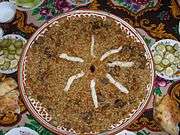
Osh plov, a staple dish in Uzbek, Tajik, and Bukharan Jewish cuisine
-
Bengali pulao, India
-

Soya Pulao, India
-
Punjabi pulao, Pakistan
-
Camel meat pulao, Pakistan
See also
References
- ↑ "Rice Pilaf". Accessed May 2010.
- ↑ Gil Marks. Encyclopedia of Jewish Food. Houghton Mifflin Harcourt, 2010. ISBN 9780544186316
- 1 2 Bruce Kraig, Colleen Taylor Sen. Street Food Around the World: An Encyclopedia of Food and Culture. ABC-CLIO, 2013, p. 384. ISBN 9781598849554
- ↑ Russell Zanca. Life in a Muslim Uzbek Village: Cotton Farming After Communism CSCA. Cengage Learning, 2010, p. 92–96. ISBN 9780495092810
- ↑ Marshall Cavendish. World and Its Peoples. Marshall Cavendish, 2006, p. 662. ISBN 9780761475712
- ↑ Navy Bean Stew And Rice Is Turkey's National Dish turkishfood.about.com
- ↑ Oxford English Dictionary, 3rd edition, 2006 s.v. 'pilau'
- ↑ Harper, Douglas. "Pilaf". Online Etymology Dictionary. Retrieved 5 June 2012.
- 1 2 K. T. Achaya (1994). Indian food: a historical companion. Oxford University Press. p. 11.
- 1 2 Priti Narain (14 October 2000). The Essential Delhi Cookbook. Penguin Books Limited. p. 116. ISBN 978-93-5118-114-9.
- ↑ Vir Sanghvi. "Biryani Nation". Retrieved 2016-06-03.
- ↑ "Uzbek Cuisine Photos: Pilaf". Retrieved 2013-05-23.
- ↑ Азербайджанская кухня, (Azerbaijani Cuisine, Ishyg Publ. House, Baku (Russian))
- ↑ Interview with Jabar Mamedov, Head Chef at the "Shirvan Shah" Azerbaijani restaurant in Kiev, 31 January 2005.
- ↑ cooking with Rita
External links
-
 The dictionary definition of pilaf at Wiktionary
The dictionary definition of pilaf at Wiktionary -
 Pulao at Wikibook Cookbooks
Pulao at Wikibook Cookbooks -
 Rice Pilaf at Wikibook Cookbooks
Rice Pilaf at Wikibook Cookbooks -
 Kashmiri Pulao at Wikibook Cookbooks
Kashmiri Pulao at Wikibook Cookbooks - All About Pilaf, History and Recipes

